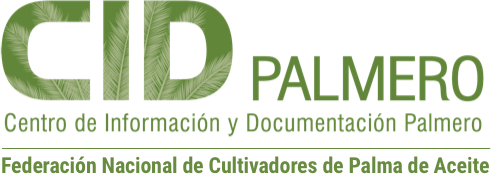| dc.creator | Aldana de la Torre, Jorge A. | |
| dc.creator | Calvache G., Hugo H. | |
| dc.creator | Arias, Diego A. | |
| dc.date | 2000-01-01 | |
| dc.date.accessioned | 2020-07-25T11:17:42Z | |
| dc.date.available | 2020-07-25T11:17:42Z | |
| dc.identifier | https://publicaciones.fedepalma.org/index.php/palmas/article/view/779 | |
| dc.identifier.uri | http://repositorio.fedepalma.org/handle/123456789/139407 | |
| dc.description | The use of Crematogaster spp. colonies for the control of L. gibbicarina in oil palm is an alternative that it has begun to be implemented in the plantations on the Northern and Central Zones of Colombia. This use includes the sowing and conservation of nectar producing plants from which the ant feeds and nests. Because of the fact that it is a new technology, it has been considered convenient to do a follow up to know its efficacy in a commercial scale, and the costs of its implementation. In order to do this the following is being evaluated: the applied methodology; the distribution of the Cassia reticulata and Urena trilobata shrubs; the maintenance of nectar producing plants that grow on the oil palm sown fields; and, evaluation of the population of L. gibbicarina and Crematogaster spp. ants. In the lots of land where the redistribution of the ant was made, the workers were accompanied to verify the quality of the action. The search of colonies for its distribution was done solely in the borders of the lots of palm maximum until the fourth palm. The bajagua, C reticulata was sowed in groups of three plants every two palms in the borders of the roads. The plants which grow inside the lot are preserved by cleaning every other alley. In 1997 the redistribution of colonies of Crematogaster was began on the 770 ha where the population of L gibbicarina was of 60 bugs per leaf. After two months the population was reduced and has maintained in an average of less than 20 individuals per leaf. With this, all chemical control intervention was eliminated. | en-US |
| dc.description | El uso de colonias de la hormiga Crematogaster spp. para el control de L. gibbicarina en palma de aceite, incluyendo la siembra y conservación de plantas nectaríferas de las cuales se alimenta la hormiga y de aquellas en las cuales nidifica, es una tecnología que comienza a implementarse en las plantaciones de las Zonas Norte y Centro del país. Por tratarse de una nueva tecnología, se ha considerado conveniente hacer un seguimiento para conocer su eficacia a escala comercial, eficiencias y costos en su implementación. Para ello se está evaluando la metodología empleada, la distribución de plantas como Cassia reticulata y Urena trilobata, conservación de plantas arvenses nectaríferas y evaluación poblacional de L gibbicarina y de la hormiga Crematogaster spp. En lotes donde se hizo la redistribución de la hormiga, eventualmente se acompañó a la cuadrilla de trabajadores para verificar la calidad de la acción. La búsqueda de colonias para su distribución se hizo únicamente en los bordes de los lotes de palma, máximo hasta la cuarta palma. La bajagua, C. Reticulata, se sembró en grupos de tres plantas cada dos palmas en los bordes de las calles. Las plantas que crecen dentro del lote se conservan limpiando calles de por medio. En el mes de abril de 1998 se inició la redistribución de colonias de Crematogaster en las 770,2 hectáreas, donde la población de L gibbicarina era de 60 chinches/hoja. Al cabo del primer año, ésta se redujo a 20 individuos por hoja, en promedio, con lo cual se eliminó cualquier intervención de control químico. | es-ES |
| dc.format | application/pdf | |
| dc.language | spa | |
| dc.publisher | Fedepalma | es-ES |
| dc.relation | https://publicaciones.fedepalma.org/index.php/palmas/article/view/779/779 | |
| dc.rights | Derechos de autor 2017 Revista Palmas | es-ES |
| dc.rights | https://creativecommons.org/licenses/by-nc-nd/4.0 | es-ES |
| dc.source | Revista Palmas; Vol. 21 Núm. especial, (2000); 167-173 | es-ES |
| dc.source | 0121-2923 | |
| dc.subject | palma de aceite | es-ES |
| dc.subject | elaeis guineensis | es-ES |
| dc.subject | agentes de control biológico | es-ES |
| dc.subject | plantas nectaríferas | es-ES |
| dc.subject | enfermedades fungosas | es-ES |
| dc.subject | leptopharsa gibbicarina | es-ES |
| dc.subject | crematogaster | es-ES |
| dc.subject | manejo integrado de plagas | es-ES |
| dc.title | Commercial management program of Leptopharsa gibbicarina Froeschner (Hemiptera: Tingidae) with the Crematogaster spp. at in oil palm plantation | en-US |
| dc.title | Programa comercial de manejo de Leptopharsa gibbicarina Froeschner (Hemíptera : Tingidae) con la hormiga Crematogaster spp. en una plantación de palma de aceite | es-ES |
| dc.type | info:eu-repo/semantics/article | |
| dc.type | info:eu-repo/semantics/publishedVersion | |


